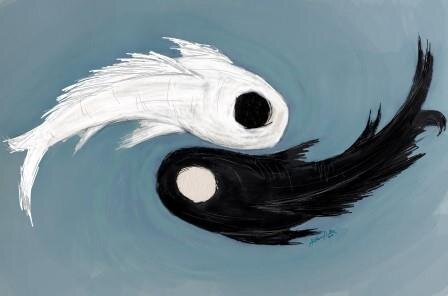Go Deeper: The Alchemy of Rolfing & Hakomi
Author’s note: No time to read? Listen to this blog & more on-the-go in the Soma Sapien Audio Journal!
Sometimes the gateway between years of chronic pain and living pain-free is a skillfully expressed “F*** you!”
You’re probably thinking I mean the semi-cathartic feeling of blowing off steam that goes with yelling that at someone. That’s actually not it at all. I’m talking about something entirely different – helping clients connect to the extremely nuanced need or missing experience that offers them their unique gateway to healing.
This was the case for one of my early “Rolf-komi” clients, and locking in on that type of transformative healing experience by blending Rolfing and Hakomi has been a major component of my practice for years.
We’ll get back to that story in a moment. First, let’s talk about Rolf-komi.
OK, first, it’s a terrible name. And definitely don’t tell the good folks at the Rolf Institute or Hakomi Institute; they won’t approve! But it is the pet name I occasionally use to talk about the magic that is my combined practice of Rolfing Structural Integration and Hakomi Mindful Somatic Psychology (click-through on those links for a deep dive into each of those bodies of work, and how they look individually).
I’m professionally certified in these two distinct, and very different, bodies of healing work. And, naturally, I’m always on the lookout for ways to blend them into something unique for my clients. So, a natural question to ask might be, “what kind of situation would call for mashing these two things together?”
Well, have you ever tried everything to solve a chronic pain challenge – PT, bodywork, acupuncture, massage, maybe even surgery – but nothing seems to unlock it? Or, have you had the experience where a challenge with a certain situation or person seems to always lead to some kind of physical discomfort as well?
Those situations describe the sweet spot I see a lot with my clients that calls for diving into work beyond the physical body. It’s in this place where skillfully unraveling a bit of our subconsciously programmed habit patterns becomes the lynch pin to a transformative healing experience.
Several years ago, I brought Hakomi into my Rolfing practice as I began to see the limitations some of my clients faced in integrating our Rolfing work back out into their lives beyond the walls of my clinic.
Combining these two practices has created an exceptional healing modality that truly explores the mind-body connection and how it influences our healing challenges. It’s an absolutely unique practice that distinguishes my work from my other Rolfing or Hakomi colleagues (in fact, there are only four Rolfers I’m aware of that are Hakomi-trained, myself included, and only two of us are Certified Hakomi Practitioners!).
So, how do these two practices fit together?
Rolfing, as a very powerful standalone modality, has a tendency to be very “top-down” in nature. Meaning, it’s like a lot of healing practices, where the Rolfer has the knowledge about what a healthier structural system would look and move like, so they lead the direction of the sessions through that lens. In the case of Rolfing, that direction very often moves through the 10-Series, Rolfing’s standardized “Recipe” for optimizing the body’s structure and function.
Hakomi, equally as powerful, is what I describe as a “bottom-up” practice, where the practitioner is following and working with the direct experiences the client is having in any given moment in order to facilitate the healing process.
“Rolf-komi” sessions then, while having the tendency to be led by bodywork and a client’s challenges in the physical realm, become much less about following the traditional arc of Rolfing’s 10 Series, or even having the main intention of touch or client movement be about changing the client’s structure or function.
Instead, the focus becomes more about the hands-on techniques or movement cues I use as a Rolfer now dropping into the experimental framework of Hakomi as new information for the client’s System that we’re both seeking feedback from. This new information may create greater freedom in the client’s physical or non-physical experience, or it may illuminate more detail about the limitation(s) we’re working to overcome.
Working this way, I may shift organically from a more top-down role where I’m leading the direction of the session, to then facilitating and following the client’s bottom-up discovery of the mental or emotional threads that are interwoven into the physical structures or symptoms we’re working through.
All pretty high-level so far, but let’s get back to that “F*** you!” to better illuminate the details of this type of unique work.
This particular client was referred to me for help resolving chronic low back pain. They’d spent a lot of time prior trying the more traditional routes of PT and massage to resolve the pain that minor lumbar disc issues were believed to be creating, but lasting relief wasn’t in sight. So, they were hopeful Rolfing would help solve things. Rolfing is typically a great option for addressing these types of challenges, so we dove into a fairly traditional 10 Series approach.
The first layer of relief arrived very quickly in our process, and after our first or second session they reported a sizeable improvement and were hopeful that full resolution was within sight.
So, we continued along our path, proceeding through about six Rolfing sessions. Nothing quite matched that initial improvement though, and each pre-session check-in began with some version of, “Well it still hurts, but not as bad as before!” It was clear our progress was plateauing rather quickly, and my client was somewhat satisfied but becoming a bit disappointed that improvement was stalling out after such initial promise.
Now, the interesting wrinkle was that, as we got to know each other a bit through our time working together, my client regularly mentioned the challenges of a relationship with a parent that was in a very frustrating place. This was a clue to me that our solution might lie beyond the physical realm and the nuts and bolts of structural health.
After discussing our stalling progress, I suggested that something in the non-physical realms (meaning mainly emotion or thought) could be our sticking point, and we agreed to the integration of Hakomi into our work to see what we could discover.
Our next session was much more Hakomi-forward, and after beginning with a basic mindful awareness practice, we began to slowly study the sensations of discomfort in my client’s body. They did a brilliant job of tracking their moment-to-moment experience, and we were able to dial into a very particular way their body wanted to move. A specific posture began to take form.
Hand on hip, body shifted to one side, jaw tense, piercing gaze, and pointing at someone they were really angry with. A very physical embodiment of the emotion churning through their System.
“I feel like I’m a teenager saying ‘f*** you!’” And then lots of tears came.
We’d locked into the exact challenge my client’s System was having. Yes, there were structural imbalances that needed to be addressed. And yes, their medical history was an important piece of the puzzle. But only addressing those had repeatedly failed to solve their pain.
Their body was a literal expression of the relational challenge that was alive during that period of their life. The tension, anger, and blunted expression of that “f*** you!” was subtly contorting their body and creating a stew of unresolvable physical pain. And, importantly, this was a previously unrecognized and unmet pattern, so it had never had the chance to be acknowledged, expressed, and met skillfully.
The next week, my client came back and reported their pain symptoms 90% resolved, and that our session had illuminated some important boundaries that needed to be put in place so their relational challenge could resolve as well.
And from there, we were able to drop right back into our Rolfing flow and the work completed beautifully. By the time we finished our work together, my client’s back pain was 95%+ improved. They left with some new practices in-tow, a whole bunch of awareness opened up, and on the road to bringing completion to their healing process.
That client’s healing journey took place in 2017. Four years later, at the time of this writing, they still had this to say about their experience:
“Moving through an experience like the sessions we had offers a life-long process of an inner self check, awareness of how the body holds, and the interconnection of body and mind. It's amazing how the spirit communicates through mind and form and at times pain or any other signs or symptoms are an opportunity to bring attention and ask what is here, in my case a good opportunity to ask why the heck are my haunches up…My personal experience with ‘Rolf-komi’ really gave me a solid insight into how emotional energy takes physical form and alters our individual structure influencing how we move in this space. Talk about letting go of old forms to open up more empowered ways of processing and being in the world.”
Pretty powerful healing story, isn’t it? If you’re interested in another great example of this type of work with my clients, head over to my recent Soma Sapien Audio Journal episode, “It’s in the Body.”
“Rolf-komi” is some incredibly powerful work. And I’ll be honest, it’s not for everyone. Not every Rolfing client of mine is interested in or needs to dip into the psycho-emotional realms as part of their healing journey. And not every Hakomi client of mine needs to call on structural bodywork as a tool in their self-discovery.
So, who’s this type of work for and when do I find it most useful?
You’re interested in a truly holistic approach to your wellness journey. Meaning, the parallel study of body, mind, emotion, and spirit.
You want to include mindfulness and self-study as an active part of your path to healing and wellness.
Other routes you’re going to resolve chronic pain – PT, massage, Rolfing, acupuncture, etc. – are hitting some sort of plateau or limitation that you can’t quite figure out.
The clues are there – for example (and like the story above), you’re experiencing physical pain concurrent with other challenging things in your life, such as a relationship, an aspect of your career, or something else on your life path.
You’re interested in addressing your pain virtually, whether that’s due to the distance from your practitioner or a preference to do this type of work in the comfort of your own space. I’ve found that touch is just one type of information that the body can use to help resolve pain, and that combining other principles of Rolfing with Hakomi, via Zoom, is a powerful way to address pain challenges. Check out my collection of virtual session demos here to find out more!
Occasionally in the case of trauma, and best concurrent with good therapy to address that trauma more directly. If you’re seeking to unravel physical pain and trauma is a known influence on your System, I’ve found that, rather often, the rigidity of a structured pain resolution path (like, say, Rolfing’s 10 Series) doesn’t account for the nuance needed to create the safety required to help bring about trauma resolution.
Lots of people are attracted to Rolfing because they think it’s “like a really deep massage.” Generally, they conflate intense pressure with depth. That’s a myth. More pressure does not equal deep work.
Leaning respectfully into the place where body and mind interface? That’s depth.
Interested in engaging with that type of depth on your wellness journey? Reach out to learn more and find out if “Rolf-komi” is right for you. Connect anytime and let’s chat a bit. I’d be honored to be part of your mind-body-spirit wellness journey!

